This list of the best power racks offers the best value and will take your home workouts to the next level. Let’s do this.
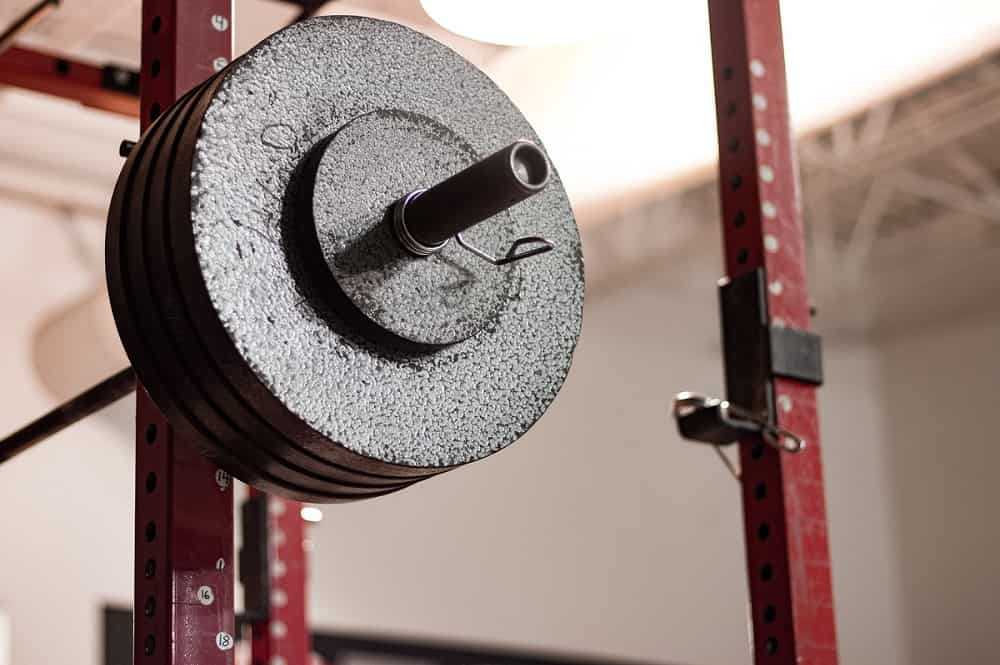
I’ve dreamed about having a complete home gym since the day I started lifting weights as a teenager.
Finally, as an adult, it’s a reality.
The commute to the gym consists of a short walk to the garage. There is never a line-up for machines. And no scheduled hours or limitations on when I can train.
But the thing holding back most gymgoers and athletes from working out at home is the equipment.
Gyms have the best of everything, from treadmills to pull-up bars to power racks.
This isn’t the case anymore.
Power racks, the centerpiece of the home-based lifter’s exercise equipment, have become highly affordable over the past several years.
No more line-ups, no more waiting for the gym to open, and no having to shell out a small fortune to get a gym-quality workout in the comfort of your own home.
Power racks (often referred to as power cages or squat cages) come in a wide variety of prices and functions.
You can get a no-frills version cage with a couple of J-hooks for the squat rack and a straight pull-up bar all the way up to a deluxe, bells-and-whistles-included version that has a dip station, pull up bar, U-hooks for bodyweight straps, and more. (It might even do your dishes if you ask nicely.)
Think about the features that you want from your power rack, and then when you are ready to start searching for the right power rack for you and your workout goals, peep my list of the best home power racks.
Let’s jump right in.
The Best Power Racks for Garage Gyms
Rogue R-3 Power Rack
⭐⭐⭐⭐⭐ Best overall power rack for home and garage gyms
Rogue makes the best fitness equipment on the planet that both commercial and home gyms can use. I don’t really know how else to put it. There are a lot of reasons for this, but the main ones are that athletes truly put Rogue equipment through their paces, Rogue’s gear looks great, and in terms of cost, Rogue’s stuff isn’t out of the reach of casual gym enthusiasts.
The Rogue R-3 is the most affordable of their range of power racks, with the no-frills version costing around $750, putting in the same price range as many of the cheap knock-off power racks that proliferate Amazon.
There are a ton of features that make this power rack the best on the market, but here are the ones that stand out the most for home and garage gym users:
Available in two different heights. The standard version of the Rogue R-3 is 7’6″ when fully assembled. If that’s too tall for you (aka you have a low ceiling workout space like a basement), they offer a 7′ version that is appropriately called the “Shorty.” The R-3 is an adjustable power rack that can fit in a wide variety of spaces.
Compact size. The footprint of the rack is surprisingly small, which is GREAT for home-based lifters who are short on space in their workout area. The footprint is 53″ across and 34″ deep. The inside of the cage is just two feet deep inside the columns.
Tools and accessories. At the top of the cage is both a fat and skinny bar for pull-ups (you can upgrade to a multi-grip bar during the ordering process–costs an additional $150, tho). Two J-hooks are included for easy barbell racking. Two safety pipes are there to keep the barbell and weights from hitting the floor. And pegs for resistance bands are at the base of the rack.
The price is killer. Some people have tons of money to burn on a squat rack. The rest of us don’t. With the $750 price tag (check Rogue’s website for most recent pricing and availability), you get the best of both worlds. A world-class piece of equipment that could just as easily be found in an NCAA Division I weight room as your garage.
Rogue also has a wide range of attachments you can add separately, including a dip station, vertical bar hanger, and much more.
There is only one drawback to this barbell power rack–Rogue is very adamant that you secure them to the floor with bolts (Rogue offers a concrete anchor kit for $14 during the customization of the rack–why not just include it to begin with?).
If you can handle that, you’ve got the best power rack for the money and durability with Rogue’s R-3 (fully reviewed here).
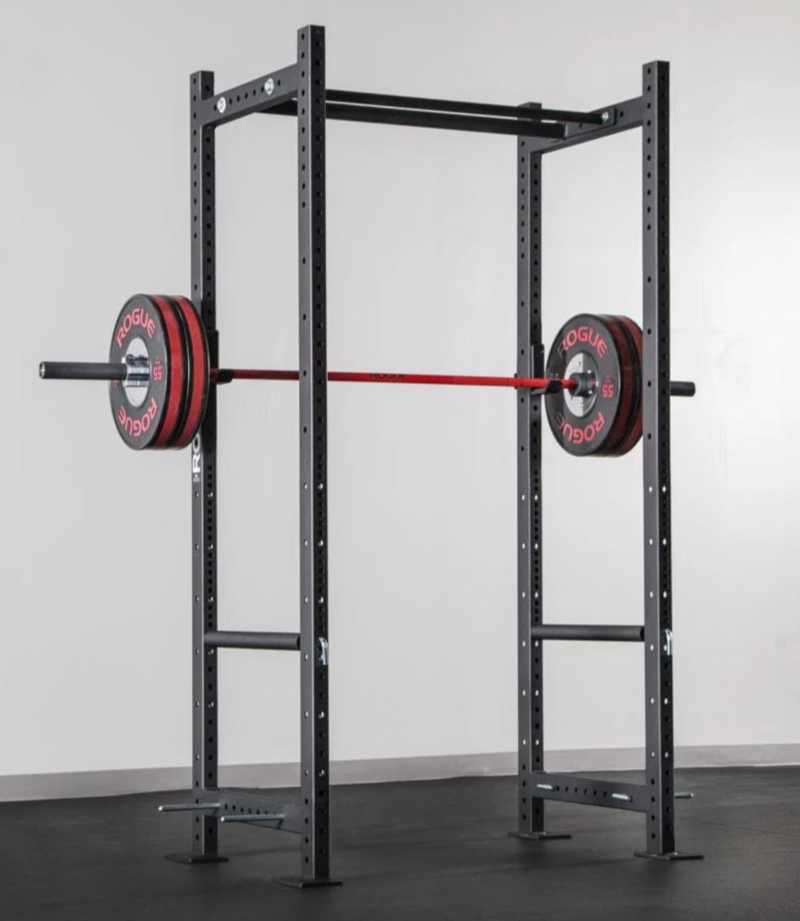
Rogue R-6 Power Rack
⭐ Best space-is-no-option power rack for home gyms
This thing is an absolute unit. I’m not even sure I would call it a power rack with all of the bells and whistles that come with it.
The main feature that separates the R-6 from other Rogue squat racks is the added space for weight storage. The extra thirty inches or so on the rack acts as a place to store all of your cast-iron weight plates and bumper plates.
Additionally, the back of the rack has six pegs with which you can hang resistance bands and/or weightlifting chains.
The width of the squat rack is the same as the R-3, but is over twice as long, with a total length of 80”. Multi-grip bar, plus both fat and skinny bars at the top of the cage.
Concrete anchors are sold separately for $14 (you can pick them up during the ordering process).
Cost-wise, this rack, which is better than most racks I’ve seen in commercial gyms, is surprisingly affordable and the no-frills version costs just $1,595 (this doesn’t include shipping—check Rogue’s website for current pricing and availability).
For lifters who have a lot of storage requirements, want the usual Rogue heavy-duty durability and quality from their power rack, and have space for the longer length, the R-6 is the best power rack for lifters who want a legit rack and have the space for it.
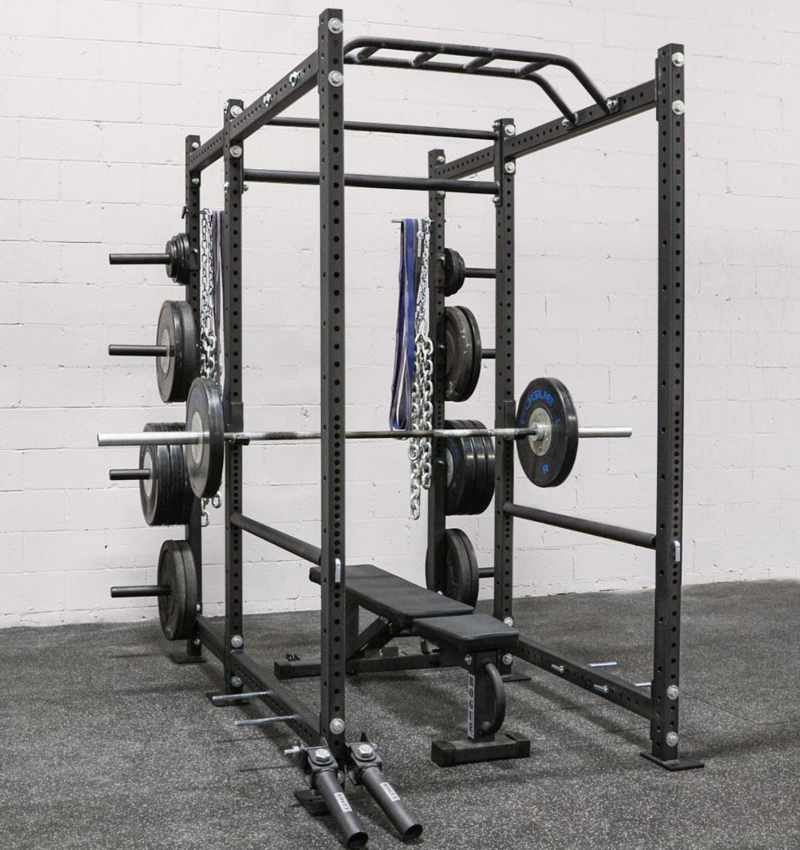
Sunny Health Power Rack
The Sunny Health Power Cage offers all of the features you would expect from a full-featured rack you would see in the gym with the affordability we all want from our home gym equipment.
Let’s kick off with the basics—the sturdy J-hooks, thick safety bar for worry-free spotting (which can be easily adjusted for more or less height), and a max capacity of 1000-pounds.
See also: 10 Best Squat Racks for Home and Garage Gyms
The pull-up bar is exactly the kind I look for with an excellent power rack, accommodating every grip variety you can think of, from narrow grip chins, wide-grip pulls, hammer chins, and so on.
An assortment of bars and pegs surround the rack. Three pegs on each side of the base can be used for lashing up resistance bands (for banded squats), and two weight plate holders at the back of the rack can be used for storage and work equally as well to “weigh down” the rack for extra stability.
The Sunny Health Power Rack also comes down with a variety of extra add-ons which can be purchased separately, including an adjustable weight bench and lat pull-down attachment.
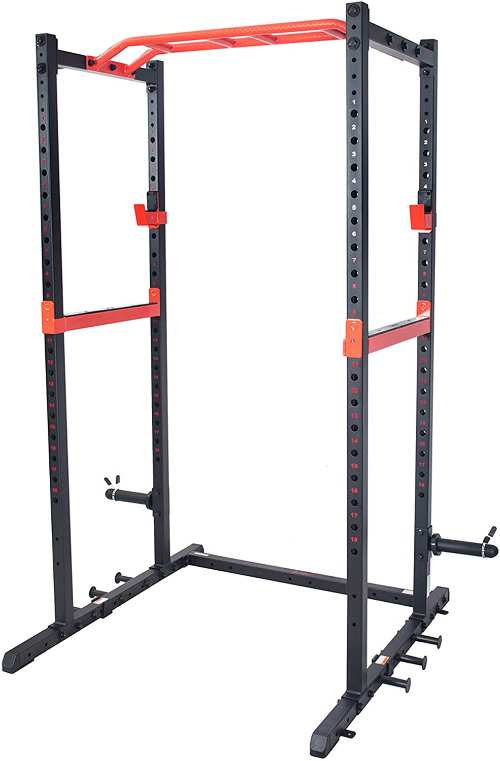
Fitness Reality 810XT Super Max Power Cage
The Fitness Reality 810XT Super Max Power Cage is one of the cheapest ways to get the full cage experience in your home gym. Exceptionally well-reviewed on Amazon, with thousands of five-star reviews (read them here), the power cage gives you the foundation for building an awesome garage or home gym.
The cage, like most, has a pull-up bar attachment at the top for chins, pulls, and hammer grip pull-ups. Two safety bars, easily adjusted for height, make sure that you can lift safely within the cage. And two chrome lock-on hooks keep the bar secure between rounds and workouts.
Fitness Reality rates this cage as having an 800-pound capacity. Although there are no weight plate holders (the cage can be ordered with add-ons including a bench and/or lat pull down, but no weight plate pegs, unfortunately), two steel bars along the back of the cage provide additional stability while you are lifting.
Footprint of the cage is 50.5 by 46.5”, and fully assembled the unit is 83.5”, making it perfect for most garages or covered outdoor spaces.
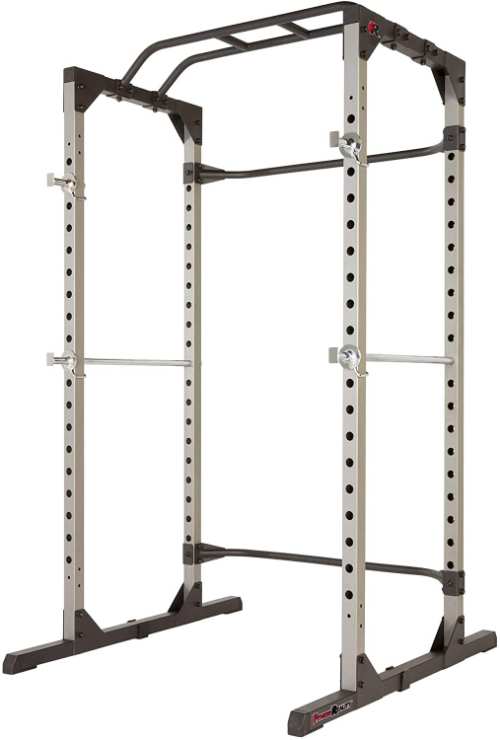
AMGYM Power Cage
The AMGYM is a good-looking power cage that nails the essentials of what I consider for an excellent power rack. The cage is surprisingly easy to assemble (I was able to put together a similar model by myself, even after having a couple of beers) and is made of super durable 2×2-inch tubular steel tubes.
Two steel safety bars slide in to provide a spot in the cage, a two pairs of J-hooks (the second one basically looks like shortened safety arms) give you plenty of options for setting down your barbell or hanging fitness equipment like your jump rope or resistance bands.
I’m a big fan of doing pull-ups, and the AMGYM Power Cage has a pull-up bar that gives you the option of every grip imaginable for pull-ups. The 1200-lb limit on the cage means I can also load up my dip belt with a couple weight plates and do weighted pull-ups.
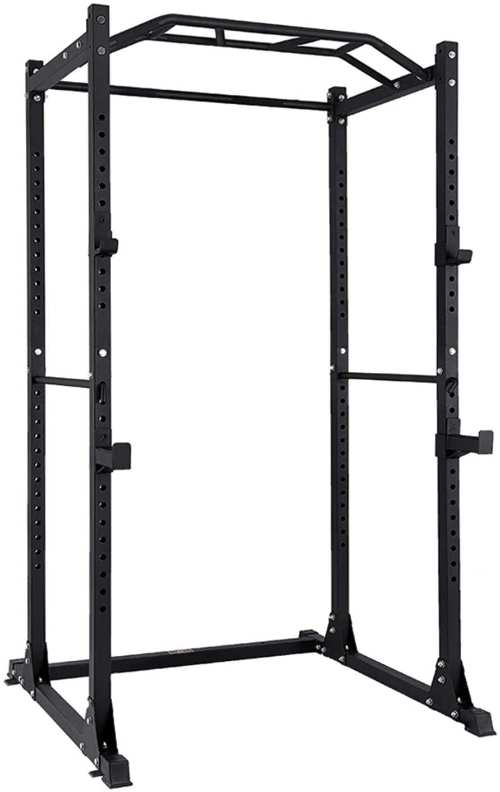
Fitness Reality X-Class Olympic Power Cage
The Fitness Reality X-Class Power Care is basically a commercial power rack repackaged and sold for home-based workouts. Fitness Reality designates it as “light commercial”, so you know this thing is going to do work in the garage.
Let’s start off with the big feature of this sturdier build: a weight capacity of up to 1500-pounds, making it the highest load-bearing cage in my round-up. A massive U-bracket at the back of the cage provides extra stability, and the extra-long footprint means no rocking, sliding, or skidding under heavy weight.
Two thick safety bars give you a worry-free spot while squatting. A pair of J-hooks and safety bars keep the barbells in place. The main safety bars have a dip station attachment, and there is a lat pull-down attachment available.
I was a little disappointed with the pull-up bar. As you have probably noticed by now, I like me my pull-ups (especially hammer grip), and the X-Class (no relation to the superheroes… as far as I know) has a bar suitable only for pulls and chins. But if that’s not a concern, no worries. (Their free-standing pull up bar, however, is pretty awesome.)
You would think that all of the features that come with this power cage would result in a hefty price tag, but the X-Class is priced in the same ballpark as the AMGYM and other no-frills cages.
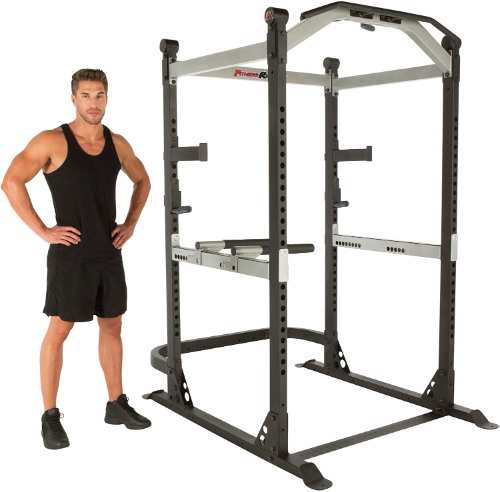
Best Power Rack for Garage Gyms – FAQs
What are the benefits of using a power rack?
Power racks are the ultimate one-stop set-up for your home gym.
Within the steel bars, you can do just about every major exercise, including squats, pull-ups, bench press, and more.
Additionally:
Makes lifting safer.
The main benefit of a rack versus a stand or a folding wall rack is that you can arrange safety bars and J-hooks to rest or catch the barbell.
Lifting a lot of weight, especially by yourself, is smarter and safer when we have some “catch” mechanisms in place.
Personally, I know that I am more willing to push the envelope with weight on the barbell when I know that the weight isn’t going to crash on the floor, or worse, on my sternum or fold me up like a rusty lawn chair.
A sturdy rack can quite literally be the thing that keeps a loaded barbell from smashing your butt up.
Power racks are hilariously versatile.
Although often colloquially referred to as a squat rack, a power rack goes way beyond that in terms of the number of exercises and lifts you can do with one.
Roll in your workout bench and you’ve got a spotter and rack for shoulder press, bench, decline bench, and so on.
Hang your TRX straps, stretch cords, and resistance bands from the columns or bars.
Use the pull-ups to blast away at your back.
And of course, the height adjustability of the hooks and safety bars mean you can unleash every variation of squats, press, and row at your training goals.
They last forever.
Power racks are built to take a beating for years and years.
Heavy-gauge steel, powder-coated to prevent rusting, and a weight-bearing design means you can punish the rack day in and day out and it will just smile at you and keep showing up.
Yes, it’s a bit of a kick to the wallet in terms of upfront cost, but the short commute, one-time investment, and the hysterical durability of racks pays for itself within a year or two.
How do I Choose a Power Rack?
Rack footprint.
Measure out how much room you have for your workout area. And then add at least another 25% of space around all sides and above the rack.
You want access to load the rack. Up top, you want clearance for doing pull-ups.
Additionally, if you are using Olympic barbells, which are a default width of 7’, don’t forget to leave room to be able to load them.
Safety features.
The main perk of a power rack is that it helps you to lift safely.
Some racks don’t include safety bars (most do, but the no-frills racks usually don’t) so double-check that the rack ships with bars or pins.

The better-known rack makers—Rogue, Iron Bull, Titan, etc.—also have a wide range of safety add-ons like straps and j-hooks that are available, too.
Weight capacity.
Even though some of us dream of achieving Strongman levels of strength, for the most part we are pushing a few hundred pounds on the barbell.
This means that just about every power rack on the market, even a lot of the cheapo racks made by no-name brands on Amazon, are good enough for bearing weight.
For people who are serious about their home gym and want something that will survive a two-story building collapsing on it, there are racks that are rated for 2,000lbs of weight.
Ultimately, the benefit of high weight capacity comes down to less wobble and sliding of the rack when putting loaded barbells back into place.
Installation.
Most entry-level racks can be assembled without the need of bolting them to the floor. Manufacturers of larger racks (Rogue is one that comes to mind) strongly recommend that the base of the rack is bolted into the floor.
Some of the larger racks now have expanded rubber-tipped feet that can be used to increase stability and reduce wobble, but if you are opening a commercial gym or know that your garage gym is going to be there for a while, bolting it into the concrete isn’t a terrible idea.
Wall-mounted racks, as you can guess, also need to be properly drilled into support beams in the wall.
Most of the inexpensive racks (like the AMGYM and Sunny Health racks) aren’t designed to be bolted into the floor. I have one that is very similar in my garage.
Even though I’ve dropped a barbell loaded with 405lbs on the safety bars, the rack didn’t come close to toppling or breaking. (Did scare the crap out of the dog, however.)
How Much Should I Spend on a Power Rack?
Power racks can be as inexpensive as $250 and can quickly increase in price to $3,000 and higher.
One of the benefits of the Covid pandemic of 2020 is the huge increase in demand for home gym equipment. More competition means more price points and racks to choose from.
There are plenty of racks on the market for a few hundred dollars that can satisfy the needs of a casual or recreational home lifter.
As the price increases, so do the number of bells and whistles. There is an almost endless number of attachments that can be affixed to racks, including lat-pull down machines, landmine attachment, and so on.
How much you spend on a power rack ultimately comes down to how often you are going to use it and how much you would like to build it out in the future.
Are power racks worth it?
Power racks make lifting weights safer and save you money in the long run. Whether you are a casual lifter, a powerlifter, or someone who is tired of wasting time driving to the gym and waiting in line for a rack, a power rack is totally worth it.
Of course, it comes down to how much you actually use it. Spending $1,000 on a steel rack that ends up collecting dust and being used to hang and store gear in the garage is overwhelmingly not worth it.
If a power rack is cheap does that make it unsafe?
While racks have gone down in price as the competition has gone up, most entry-level power racks are still very safe. In my own experience, racks tend to be stronger than advertised in order to discourage misuse and allow for a buffer for habitual envelope-pushers.
Assemble it properly, anchor the bottom of the rack (consider getting some weight storage pins and loading the pin with plates to weigh down the bottom of the rack and stabilizing it), and avoid the urge to power-slam loaded barbells onto it, and you will be fine.
That said, spending a bit more on a rack isn’t a terrible idea, either. The more expensive racks have thicker columns (3” versus 2”) and a wider base, making the sturdier and “safer.”
What’s the difference between squat racks and power racks?
Although the two are frequently interchanged, power racks and squat racks are not the same.
A squat rack is an “open” rack where if you fail a squat, the barbell is going to roll off your back and onto the floor. They have a smaller footprint, better suited for experienced lifters short on space. A squat rack also comes in a variety of formats, from stands to half cages.
A power cage allows you to squat off the front of the cage, but you can also squat inside the cage with safety bars or straps to catch the barbell if you fail. Power racks, because of their larger base, are also more stable.
In terms of cost, both are comparable. Squat stands and half racks still come in at a few hundred dollars, so if you have the space, spring a few extra dollars for the added stability and peace of mind that comes with a power rack.
Didn’t Find the Perfect Power Rack for Your Home Gym?
We’ve reviewed countless squats racks and stands. Here are more of them.
Best Half Squat Racks. Half racks are a great way to get almost all of the benefits of a power cage with a smaller price tag and footprint.
Best Squat Stands. For the minimalist and experienced lifter, squat stands provide the bare essentials—a stand specifically for holding the barbell and nothing else.
The 14 Best Attachments for Your Power Rack (and Where to Buy). A power rack is just the beginning when it comes to building a killer home gym. Here is a breakdown of the best attachments for your rack, including accessories for increased safety, more exercises, and storage.

